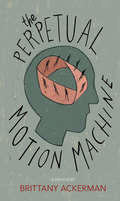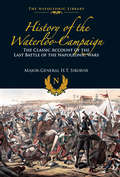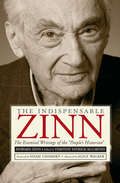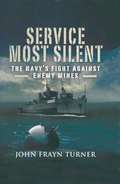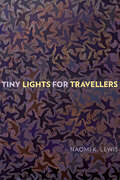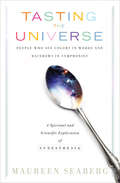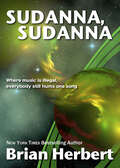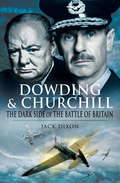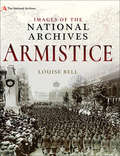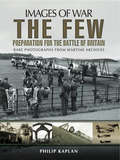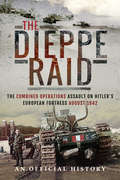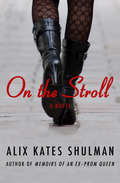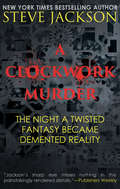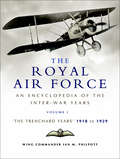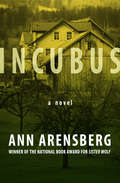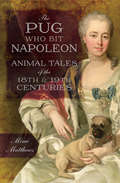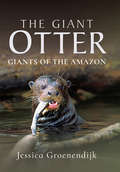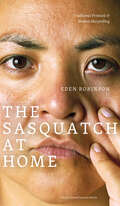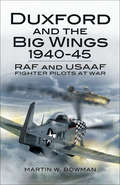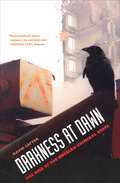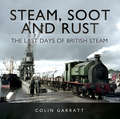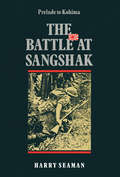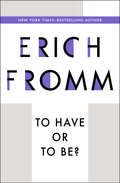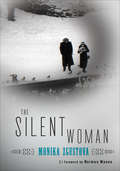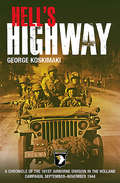- Table View
- List View
The Perpetual Motion Machine: A Memoir
by Brittany AckermanA memoir exploring a young woman&’s troubled childhood, her bond with her older brother, and the toll of drugs and alcohol on their lives. Inspired by a brother&’s high school science project—a perpetual motion machine that could save the world—The Perpetual Motion Machine is a memoir in essays that attempts to save a sibling by depicting the visceral pain that accompanies longing for some past impossibility. The collection has been a science project in its study of memory, in the calculation and plotting of the moments that make up a childhood. The preparation has been &“in the field&” in that it is built upon the gathering of lived experience; the evidence is photo albums, family interviews, and anecdotes from friends. The project has been one giant experiment—to see if they can all make it out alive.&“Full of hard-won wisdom, beautifully written and deeply moving . . . an exquisite chronicle of family and trauma and hope and longing, and announces Brittany Ackerman as an exciting new voice in letters.&” —Alan Heathcock, author of VOLT and 40 &“[An] instantly engaging and wildly engrossing memoir. . . . Her prose is accessible and affecting, and her family story is exquisite in its luminous detail and intimacy, full of heartbreak and humor.&” ―Davy Rothbart, author of My Heart is an Idiot, creator of FOUND Magazine, and contributor to This American Life&“Told in simple, spare language, Ackerman&’s story is powerful not only for the story it tells, but also for the eloquent silences and chronological ruptures that symbolize the painfully fractured nature of her life and that of her brother. A brief but poignant memoir.&” —Kirkus Reviews
History of the Waterloo Campaign: The Classic Account of the Last Battle of the Napoleonic Wars (The Napoleonic Library)
by H.T. SiborneCaptain William Siborne became an ensign in the 9th Foot in 1813 and was sent to France in 1815 as part of a battalion despatched to reinforce Wellingtons army. A notable topographer, after the events that year he was commissioned to create a scale model of the Battle of Waterloo, for which he carried out extensive research, writing to officers in the allied forces present to obtain information. The subsequent correspondence amounted to the largest single collection of primary source material on the subject ever assembled. After he had completed his model, which is today on public display in the National Army Museum in London, he used the mass of information he had gathered to produce his History of the Waterloo Campaign, which was at the time the most detailed account of the operations of 1815 and is still considered a classic work on the subject.Sibornes history of Waterloo, the latest addition to Frontline's growing Napoleonic Library, is essential and gripping reading for all those who are interested in how this famous battle was fought and won.
The Indispensable Zinn: The Essential Writings of the "People's Historian"
by Howard ZinnA &“well-chosen anthology of the radical historian&’s prodigious output,&” from A People&’s History of the United States and lesser known sources (Kirkus Reviews). When Howard Zinn died in early 2010, millions of Americans mourned the loss of one of the nation&’s foremost intellectual and political guides; a historian, activist, and truth-teller who, in the words of the New York Times&’s Bob Herbert, &“peel[ed] back the rosy veneer of much of American history to reveal sordid realities that had remained hidden for too long.&” A collection designed to highlight Zinn&’s essential writings, The Indispensable Zinn includes excerpts from Zinn&’s bestselling A People&’s History of the United States; his memoir, You Can&’t Be Neutral on a Moving Train; his inspiring writings on the civil rights movement, and the full text of his celebrated play, Marx in Soho. Noted historian and activist Timothy Patrick McCarthy provides essential historical and biographical context for each selection. With a foreword by Noam Chomsky and an afterword from Zinn&’s former Spellman College student and longtime friend, Alice Walker, The Indispensable Zinn is both a fitting tribute to the legacy of a man whose &“work changed the way millions of people saw the past,&” and a powerful and accessible introduction for anyone coming to Zinn&’s essential body of work for the first time (Noam Chomsky).
Service Most Silent: The Navy's Fight Against Enemy Mines
by John Frayn TurnerFrom the very outset of war Nazi Germany demonstrated its determination and ability to lay siege to the British Isles by the laying of mines in shipping lanes. Losses to both merchant ships and naval vessels became a serious factor. If supplies continued to be lost by a combination of U-Boat and mine attacks the very survival of the nation was at risk. Finding counter-measures to the German mine offensive was thus a top priority. The responsibility for this vital work rested with a small group of highly skilled and courageous naval specialists based at HMS Vernon, the RN's mine and torpedo shore-base at Portsmouth. Ranged against them was a growing and ingenious array of weapons: magnetic, acoustic, oyster, booby-trap mines to name but four varieties. Some were laid by boat, others dropped from the air. The story of HMS Vernon's contribution led by men such as Commander JGD Ouvry DSO and Captain R L Lewis DSO and many other courageous figures has been written by John Frayn Turner, the distinguished historian who served with them.He adopts a fast moving style to describe the near continuous struggle to detect, understand and master the best efforts of the German war machine. He brings home the constant deadly danger faced by these highly skilled and dedicated men.
Tiny Lights for Travellers (Wayfarer)
by Naomi K. LewisGovernor General’s Award Finalist: A “wry, moving” memoir of a woman retracing her grandfather’s escape from Amsterdam during the Holocaust (Alison Pick, Booker-nominated author of Between Gods).Why couldn’t I occupy the world as those model-looking women did, with their flowing hair, pulling their tiny bright suitcases as if to say, I just arrived from elsewhere, and I already belong here, and this sidewalk belongs to me?When her marriage suddenly ends, and a diary documenting her beloved Opa’s escape from the Nazi-occupied Netherlands in the summer of 1942 is discovered, Naomi Lewis decides to retrace his route to freedom. Travelling alone from Amsterdam to Lyon, she discovers family secrets and her own narrative as a second-generation Jewish Canadian. With vulnerability, humour, and wisdom, Lewis’s memoir of her journey, interspersed with excerpts from her grandfather’s diary, asks tough questions about her identity as a secular Jew, the accuracy of family stories, and the impact of the Holocaust on subsequent generations.
Tasting the Universe: People Who See Colors in Words and Rainbows in Symphonies
by Maureen Seaberg&“Explores a dimension of synesthesia long encountered in reports of synesthetes: its relation to mystical and artistic vision . . . fascinating accounts.&”—Patricia Lynne Duffy, author of Blue Cats and Chartreuse Kittens What happens when a journalist turns her lens on a mystery happening in her own life? Maureen Seaberg did just that and lived for a year exploring her synesthesia. The wondrous brain trait is often described as blended senses, but for Maureen, synesthesia is not an idle &“brain tick&” that can be explained away by science (although it does offer some important clues). It is a unique ability to tap into and reveal a greater creative universe and even the divine. Join her as she visits top neuroscientists, rock stars, violinists, other synesthetes, philosophers, savants, quantum physicists and even Tibetan lamas in her journey toward the truth. Step into Maureen&’s shimmering alternate universe as she explores this fascinating subject, combining clear explanations of groundbreaking scientific research with an exploration of deeper spiritual truths. &“Tasting the Universe is not only the brilliant writing of a top, professional journalist looking in on a strange but romantic phenomena, but it is the writing of a person who could embrace the feelings of those she interviews, because author Seaberg herself possesses this remarkable gift of synesthesia. I predict when you pick up this book, you will be unable to put it down, as it will open up for you a whole new world in our universe.&”—The Amazing Kreskin
Sudanna, Sudanna
by Brian HerbertOn the peanut-shaped planetoid of Ut, a 150-million-year-old computer named Mamacita rules with dictatorial control. Her every whim is a steadfast rule, and no command is stronger than the ban of Sudanna, the wind that sweeps across Ut spreading the liberating sounds of music.Hiley OIV is one of Ut&’s most conscientious inhabitants, a man so afraid of losing his head (utpeople have very precarious necks) that a Bad Thought almost never enters his mind. But now his teenage daughter has fallen in love with Prussirian BBD—Ut&’s most notorious outlaw—a man who has broken Mamacita&’s cardinal rule: he makes music.
Dowding & Churchill: The Dark Side of the Battle of Britain
by Jack DixonA WWII historian shines a light on an unsung hero of the Battle of Britain and reveals the conspiracy that led to his undignified dismissal.From 1936 to 1940, Air Chief Marshal Sir Hugh Dowding built Britain’s cutting edge defensive force, Fighter Command. Thanks to his foresight, Fighter Command was the only military arm prepared for battle when war was declared against Germany. Dowding’s leadership of Fighter Command was crucial to achieving victory in the Battle of Britain—one of the decisive battles of Western Civilization.Though the importance of the Battle of Britain was recognized at the time, Dowding was relieved of his command shortly afterward—and shuffled into retirement without recognition. This book reveals that this was the result of a shabby conspiracy by fellow officers. In March 1941, the Air Ministry published a brief account of the battle that made no mention of Dowding.Churchill was furiously indignant. But in November 1940 he had acquiesced in Dowding’s removal. Why? And what are the factors that led to Dowding’s dismissal in the first place? In this thought-provoking and authoritative book Jack Dixon answers these questions and explains Dowding’s true greatness.
Armistice: Armistice (Images of the National Archives)
by Louise Bell11th November 1918 saw the signing of the armistice that ended fighting between the Allies and Germany.This book will take the reader through the final year of the First World War and everything that led up to this day. Starting from the Spring Offensive, photos and images from The National Archives will highlight important points ranging from the last 100 days to the signing of the various treaties before this final armistice, finishing with a look at the Peace Parade in 1919. The physical and mental effects of the war will also be examined, and show how the war never really ended in 1918 for many.Many rarely seen images will be provided to support the narrative and further highlight the depth of The National Archives' First World War records.
The Few: Rare Photographs From Wartime Archives (Images of War)
by Philip KaplanThis new addition to the Images of War series is sure to prove welcome, illustrating as it does the preparatory stages of the iconic Battle of Britain. Whilst the country geared up for action, the air forces rallied, readying the high-performance Hawker Hurricane and Supermarine Spitfire fighters that were to characterize this aerial conflict so dramatically. The nine month period that elapsed prior to the German dive-bombing attacks on British shipping in the English Channel (an event that signaled, what Winston Churchill labeled, The Battle of Britain) is the focus of this photographic study. The so-called 'Phoney War' that played out under the leadership of William Maxwell Aitken, the British Minister of Aircraft Production, saw all arms of the Air Force tasked with the job of ensuring that Britain and its forces were prepared for the German challenge that existed on the horizon.Images of some of pilots and various aircrews preparing for battle feature alongside shots of Spitfires in waiting, volunteer ambulance crews in readiness, civilians filling sandbags on the beaches of Britain to be used in an effort to protect its buildings. All these images serve to illustrate the times at hand, and the co-operative, resilient spirit of British pilots and civilians during this anticipatory period of uncertainty. Military enthusiasts and historians of the Second World War will be intrigued by the new insights opened up by these images. All are accompanied by Kaplan's illuminating prose, setting each image within context. A second volume will follow, focussing on the Battle itself, and The Few who achieved so much.
The Dieppe Raid: The Combined Operations Assault on Hitler's European Fortress, August 1942
by UK War OfficeA battle summary of Britain&’s raid on the French port town of Dieppe during World War II. Winston Churchill was under pressure. The Soviets felt that they were fighting the Germans by themselves. Stalin demanded Britain open a second front to draw German forces away from the east. Though the advice Churchill received from his staff was that an invasion of France would not be possible for at least another year, the British Prime Minister knew he had to do something to help the Russians. The result was a large-scale raid upon the port of Dieppe, chosen as it was thought that the success of any invasion would depend on the capture of a major port to enable heavy weapons, vehicles, and reinforcements to be landed in support of the landing forces. It would not be the second front that Stalin wanted, but at least it would demonstrate Britain&’s intent to support the Soviets. Plus, it provided a rehearsal for the eventual invasion. The raid upon Dieppe, Operation Jubilee, was eventually scheduled for 19 August 1942. The assault was the most ambitious Allied attack against the German Channel defenses of the war so far, involving some 6,000 infantry, 237 naval vessels, and seventy-four squadrons of aircraft. Though the debate surrounding Jubilee&’s purpose and cost has raged in the years since the war, many vital and important lessons were learned. All these factors are covered in this official battle summary, a detailed and descriptive account of the Dieppe Raid, which was written shortly after the war and is based on the recollections of those who were involved.
On the Stroll: A Novel (Cassandra Editions Ser.)
by Alix Kates ShulmanA teenage runaway from Maine gets an eye-opening introduction to life on the streets of New York CityRobin catches a bus from her home in Maine to New York City to escape her tyrannical father. With no money and little hope of finding a decent job, the sixteen-year-old girl is easy prey for a hard-luck pimp named Prince. He quickly gains Robin&’s trust and introduces her to the seedy underbelly of the city, a world of sex, drugs, and lies in which she must fight to survive. A homeless woman named Owl, who was once beautiful and bold, befriends Robin as they both struggle to take control of their lives. On the Stroll is a moving, gritty picture of the people who find themselves on society&’s margins and a heartrending look at the ultimate costs of homelessness and prostitution.
A Clockwork Murder: The Night A Twisted Fantasy Became A Demented Reality
by Steve Jackson&“Wonderful and dark . . . a journey into the minds of two men who together become one killer&” from the New York Times bestselling true crime author(Blaine L. Pardoe, author of A Special Kind of Evil). In April 1997, pretty, 22-year-old Jacine Gielinski stopped her car at a red light in Colorado Springs, Colorado. She had no idea that the two young men looking at her from the car next to hers would in that moment decide she would be their target for unspeakable horrors. George Woldt and Lucas Salmon were an unlikely pair of best friends, much less killers. Woldt was a fast-talking, well-dressed ladies&’ man who boasted of his sexual conquests. Salmon was deeply religious and socially misfit, obsessed with losing his virginity. Woldt was the leader, Salmon his willing follower, but neither had been in serious trouble with the law. However, inspired by the cult movie, A Clockwork Orange, with its dystopian violence, they fantasized for months what it would be like to abduct, rape, torture and murder a woman. Then, aroused by watching ultra-violent pornography, they decided to act upon their evil thoughts. Revised and updated with a new afterword from the author, A Clockwork Murder recounts the steps that led to an unthinkable crime and its impact on a community, as well as the friends and especially the parents of an innocent young woman who paid with her life for being in the wrong place at the wrong time. &“Jackson&’s sharp eye misses nothing in the painstakingly rendered details.&”—Publishers Weekly
The Royal Air Force: An Encyclopaedia Of The Raf Between The Two World Wars - 1918 To 1929 (The Encyclopedia of the Inter-War Years #1)
by Ian M. PhilpottThe inter-war years between 1918 and 1939 saw the newly created Royal Air Force fighting for its very existence politically, being dispatched to the remotest corners of the British Empire and its Protectorates in various policing roles and then finally engaged in a headlong rush to modernize in the face of the new German Fascist regime that was threatening British and European freedom. Yet this important period in RAF history and its effect on political and military rationale during the period has never been completely documented. This exhaustive and comprehensive reference is the most detailed work to be published on the subject. The author gives full information on the changing structure of the Force during the period, squadron operations, political machinations and their effects, the airplanes and their equipment, the personnel, technical advances in navigation and breakthroughs achieved in engine performance. The book is cross-referenced throughout, extremely well illustrated and contains an abundance of location maps and other diagrams. This book will become a Bible for anyone interested in the history of the RAF.This work has been reviewed by personnel at the RAF Historical Branch who praise it.
Incubus: A Novel
by Ann ArensbergNational Book Award winner Ann Arensberg brings readers a modern horror story about evil descending on an insular Maine townIt begins with the theft of six candles from the church altar, a few herbs found strewn in the local graveyard. In the summer of 1974, the prosperous farming community of Dry Falls, Maine, is hit by a brutal heat wave. Crops fail. Drought blights once-verdant lawns. Men inexplicably lose all interest in sex, while women complain of erotic nocturnal visitations. Farm animals give birth to monstrosities. An unholy, unimaginable force is disrupting the natural order—and it seems to be specifically targeting Dry Falls.Narrated by the careful and practical Cora Whitman, wife of the town pastor, this tale of creeping strangeness quickly turns sinister. Incubus subtly builds to its shattering climax with Cora at its epicenter. Expertly interweaving themes of faith, religion, and marriage with that of the supernatural, this modern horror classic will enthrall fans of Ann Arensberg and attract a legion of new readers.
The Pug Who Bit Napoleon: Animal Tales of the 18th & 19th Centuries
by Mimi MatthewsFrom Victorian cat funerals to a Regency-era pony who took a ride in a hot air balloon, a collection of history&’s quirkiest—and most poignant—animal tales. Meet Fortune, the Pug who bit Napoleon on his wedding night, and Looty, the Pekingese sleeve dog who was presented to Queen Victoria after the 1860 sacking of the Summer Palace in Peking. The four-legged friends of Lord Byron, Emily Brontë, and Prince Albert also make an appearance, as do the treasured pets of Alexander Pope, Samuel Johnson, and Charles Dickens. Less famous, but no less fascinating, are the animals that were the subject of historical lawsuits, scandals, and public curiosity. There&’s Tuppy, the purloined pet donkey; Biddy, the regimental chicken; and Barnaby and Burgho, the bloodhounds hired to hunt Jack the Ripper. Wild animals also get a mention in tales that encompass everything from field mice and foxes to alligators and sharks lurking in the Thames. Using research from eighteenth- and nineteenth-century books, letters, and newspapers, Mimi Matthews brings each animal&’s unique history to vivid life. The details are sometimes humorous, sometimes heartbreaking, but the stories are never anything less than fascinating reading for animal lovers of all ages.
The Giant Otter: Giants of the Amazon
by Jessica Groenendijk&“The charisma of these huge, Amazonian &‘river people&’ burns through even the most factual descriptions, emphasized by an abundance of photographs.&” —BBC Wildlife The aptly named giant otter is exceptionally well adapted to life in rivers, lakes and wetlands in tropical South America. Known in Spanish as lobo del rio or &‘river wolf,&’ it can be as long as a human is tall and is the most social of the world&’s thirteen otter species. Each individual is identifiable from birth by its pale throat pattern, as unique as your fingerprint. Giant otters are top carnivores of the Amazon rainforest and have little to fear . . . except man. There are many reasons why scientists and tourists alike are fascinated by this charismatic species. Spend a day in the life of a close-knit giant otter family and you&’ll realize why. Learn about their diet and hunting techniques, marking and denning behavior, and breeding and cub-rearing strategies, including shared care of the youngest members. Become familiar with the complex life histories of individual otters over their 15-year lifespans. And accompany a young disperser during the trials and tribulations of a year spent looking for a mate and a home of its own. &“The descriptions of the otters, their habits and their homes along with tons of jaw dropping photographs, made me feel (almost) like I was there myself. Treat yourself to a book that will transport you to a place like nowhere else on earth, where you explore the wilds of the Amazon from your own garden.&” —Cayocosta 72 &“An intimate, educational and a dedicated love letter to the Giant Otter.&” —Queen of Geekdom
The Sasquatch at Home: Traditional Protocols & Modern Storytelling (The Henry Kreisel Memorial Lecture Series)
by Eden RobinsonThe award-winning Indigenous author of Monkey Beach shares tales from her family, her life, and her culture.In March 2010 the Canadian Literature Centre hosted award-winning novelist and storyteller Eden Robinson at the 4th annual Henry Kreisel Lecture. Robinson shared an intimate look into the intricacies of family, culture, and place through her talk, “The Sasquatch at Home.” Robinson’s disarming honesty and wry irony shine through her depictions of her and her mother’s trip to Graceland, the Potlatch where she and her sister received their Indian names, how her parents first met in Bella Bella (Waglisla, British Columbia) and a wilderness outing where she and her father try to get a look at b’gwus, the Sasquatch. Readers of memoir; Indigenous literatures, histories and cultures; and fans of Robinson’s delightful, poignant, sometimes quirky tales will love The Sasquatch at Home.“[Robinson] strikes sweetly at the commonality of people rather than narrowing in on cultural differences. The entire book is fast, colloquial, and engaging; concise enough to be read in one sitting, yet retaining the weightiness of a larger work. Its brevity makes it an ideal re-read and the second reading proves just as entertaining. The funny parts remain funny, the rendering of landscapes evocative and intimate, and the general themes stay relevant. Through rich and often comic dialogue and her painterly descriptions of the northwest landscape, Eden Robinson presents a glimpse into her community with the delicious, whispered quality of a well-told, yet well-protected, family story.” —Cara-Lyn Morgan, The Malahat Review, Winter 2011“Offers the reader a taste of her skill as a storyteller. The book is a tiny gem. . . . This brilliant little jewel, under fifty pages, offers readers a quick, but intense opportunity to experience the work of a rising Canadian writer. Like her novel, Monkey Beach, the accessibility of The Sasquatch at Home suggests its appropriateness for use in undergraduate courses. Above all, it is an essential acquisition for anyone with an interest in Pacific Northwest or Native Canadian studies, but it is also a find for those who just like a good story.” —Amy J. Ransom, American Review of Canadian Studies
Duxford and the Big Wings, 1940–45: RAF and USAAF Fighter Pilots at War
by Martin W. BowmanA pulsating account of the young RAF and American fighter boys who flew Spitfires, Hurricanes, Thunderbolts and Mustangs during 1940-45. It is unique in that the story is told using first person accounts from RAF, German and American Eagles who fought in the skies over England in the Battle of Britain in the summer of 1940 and the great air offensives over occupied-Europe from 1942 onwards. The first five and a half chapters cover the Battle of Britain period when the RAF squadrons fought dog fights with the Luftwaffe and then fought them in gathering strength using the Big Wings to meet the bomber fleets attacking London. The second part of the book covers the Eagle squadron period, which was expanded with Americas entry into the war. The action moves to the USAAF Big Wings of Thunderbolts and Mustang fighters that flew escort missions and dueled with the Luftwaffe over the continent during the massive bomber raids on German targets in France, the Low Countries and the Reich itself. A whole host of incredible first hand accounts by British, Polish, Czech, German and American fighter pilots permeate the action and describe the aerial battles as only they can. This unique book also includes many accounts and photos that have not previously been seen before while the rich mix of combat accounts from all sides are brought together for the first time in one volume.
Darkness at Dawn: The Rise of the Russian Criminal State
by David Satter&“The Russia that Satter depicts in this brave, engaging book cannot be ignored . . . Required reading for anyone interested in the post-Soviet state&” (Newsweek). Anticipating a new dawn of freedom after the disintegration of the Soviet Union, Russians could hardly have foreseen the reality of their future a decade later: A country impoverished and controlled at every level by organized crime. This riveting book views the 1990s reform period through the experiences of individual citizens, revealing the changes that have swept Russia and their effect on Russia&’s age-old ways of thinking. &“With a reporter&’s eye for vivid detail and a novelist&’s ability to capture emotion, he conveys the drama of Russia&’s rocky road for the average victimized Russian . . . This is only half the story of what is happening in Russia these days, but it is the shattering half, and Satter renders it all the more poignant by making it so human.&” —Foreign Affairs &“[Satter] tells engrossing tales of brazen chicanery, official greed and unbearable suffering . . . Satter manages to bring the events to life with excruciating accounts of real Russians whose lives were shattered.&” —The Baltimore Sun &“Satter must be commended for saying what a great many people only dare to think.&” —The Globe and Mail (Toronto) &“Humane and articulate.&” —The Spectator &“Vivid, impeccably researched and truly frightening . . . Western policy-makers would do well to study these pages.&” —National Post
Steam, Soot and Rust: The Last Days of British Steam
by Colin GarrattThe disappearance of the steam locomotive in the land of its birth touched the hearts of millions, but when the government announced the Modernisation Plan for Britain's railways in 1955, under which steam was to be phased out in favour of diesel and electric traction, few people took it seriously. Steam locomotives were an integral part of our daily lives and had been for almost one and a half centuries. Furthermore, they were still being built in large numbers. It was popularly believed that they would see the century out and probably well beyond that. But the reality was that by 1968 a mere thirteen years after the Modernisation Plan steam traction had disappeared from Britain's main line railways. It was harrowing to witness the breaking up of engines, which were the icons of their day, capable of working long-distance inter-city expresses weighing 400 tons on schedules faster than a mile a minute. Top speeds of 100mph were not unknown.This book chronicles the last few years as scrap yards all over Britain went into overtime, cutting up thousands of locomotives and releasing a bounty of more than a million tons of scrap whilst the engines, which remained in service, were a shadow of their former selves; filthy, wheezing and clanking their way to an ignominious end. The pictures in this book are augmented by essays written by Colin Garratt at the time. Although steam disappeared from the main line network it survives in everdwindling numbers on industrial systems such as collieries, ironstone mines, power stations, shipyards, sugar factories, paper mills and docks. In such environments steam traction eked out a further decade and during this time many of the industrial locations closed rendering the locomotives redundant. The British steam locomotive was born amid the coalfields and was destined to die there one and three quarter centuries later.
The Battle At Sangshak: Prelude to Kohima
by Harry SeamanThis book tells the story of a small, yet significant, battle that was a precursor to the better known battles for Imphal and Kohima.
To Have or To Be? (Bloomsbury Revelations Series)
by Erich FrommFrom the legendary psychoanalyst who wrote The Art of Loving and Escape from Freedom: A profound critique of materialism in favor of living with meaning. Life in the modern age began when people no longer lived at the mercy of nature and instead took control of it. We planted crops so we didn&’t have to forage, and produced planes, trains, and cars for transport. With televisions and computers, we don&’t have to leave home to see the world. Somewhere in that process, the natural tendency of humankind went from one of being and of practicing our own human abilities and powers, to one of having by possessing objects and using tools that replace our own powers to think, feel, and act independently. Fromm argues that positive change—both social and economic—will come from being, loving, and sharing. This ebook features an illustrated biography of Erich Fromm including rare images and never-before-seen documents from the author&’s estate.
The Silent Woman
by Monika ZgustovaThis &“exhilarating novel&” of love, longing, and exile &“captures the passion of a century in turmoil&” (Rahna Reiko Rizzuto, author of Hiroshima in the Morning). From the &“outstanding&” Czech writer Monika Zgustova, The Silent Woman depicts a twentieth-century woman&’s life against a backdrop of war and political turmoil (Vaclav Havel). Sylva, half Czech and half German, is born into an aristocratic family and lives in a castle outside Prague. She marries a man she doesn&’t love and is seduced by the joyful madness of Paris in the 1920s as an ambassador&’s wife. When the Nazis force her to state her loyalty, she capitulates, not realizing how this decision will inform and haunt the rest of her life. Sylva&’s story is interwoven with that of her son Jan, a world-renowned mathematician and Russian emigre living in the United States, who exudes the restlessness of a man without a country. With insight and candor, Zgustova weaves a multigenerational narrative of the consequences of moral choices and how individuals come to terms with their own forms of exile.
Hell's Highway: A Chronicle of the 101st Airborne Division in the Holland Campaign, September–November 1944 (Brothers In Arms Ser.)
by George KoskimakiThe author of The Battered Bastards of Bastogne does a &“superb job of telling the history the 101st Airborne Division during Operation Market Garden&” (Kepler&’s Book Reviews). Hell&’s Highway is a history, most of which has never before been written. It is adventure recorded by those who lived it and put into context by an author who was also there. It is human drama on an enormous scale, told through the personal stories of 612 contributors of written and oral accounts of the Screaming Eagles&’ part in the attempt to liberate the Netherlands. Koskimaki is an expert in weaving together individual recollections to make a compelling and uniquely first-hand account of the bravery and deprivations suffered by the troops, and their hopes, fears, triumphs, and tragedies, as well as those of Dutch civilians caught up in the action. There have been many books published on Operation Market Garden and there will surely be more. This book, however, gets to the heart of the action. The &“big picture,&” which most histories paint, here is just the context for the real history on the ground.
